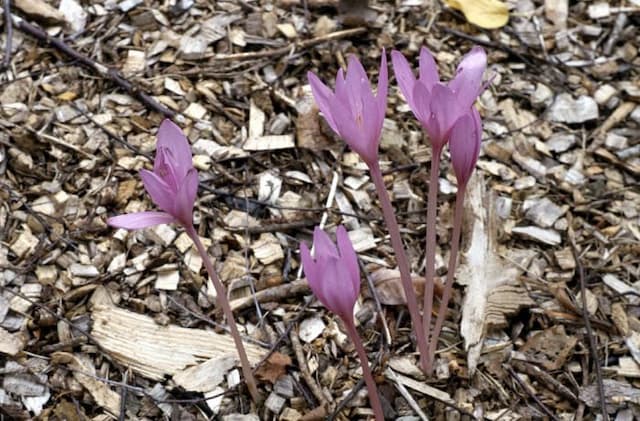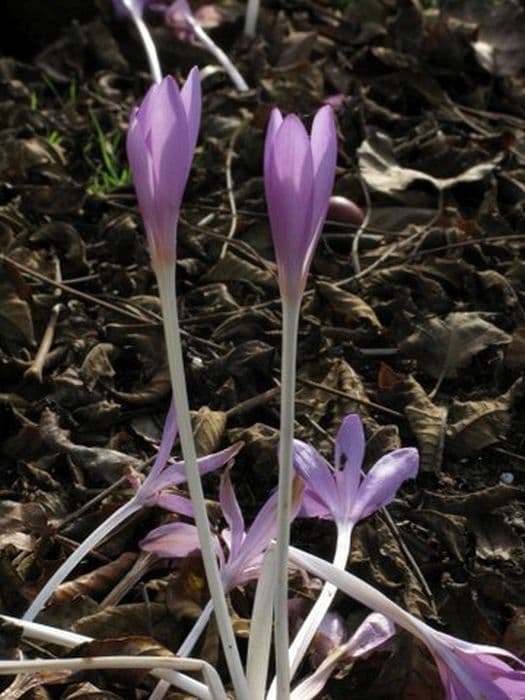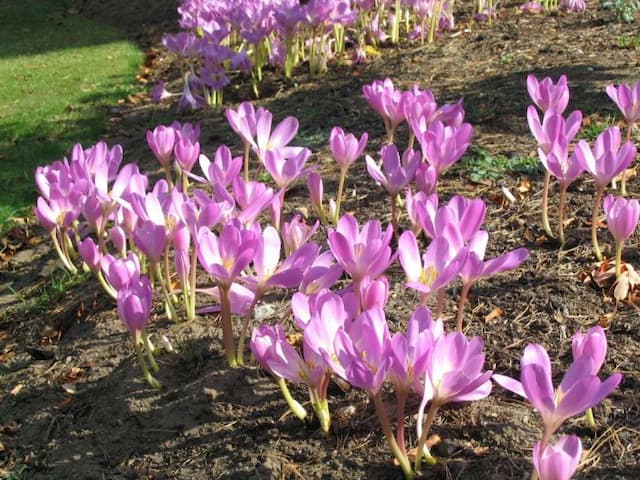Autumn Crocus Colchicum cilicicum 'Purpureum'

ABOUT
The plant known commonly as autumn crocus displays an eye-catching burst of color, typically blooming with vibrant purplish-pink hues that can add life to a garden during the fall season. Each individual flower of this cultivar is shaped like a goblet, opening upwards to greet the sky. The petals are smooth and exhibit a rich coloration that can range from deep purple to a lighter shade, almost magenta, and may have delicate veining adding to the visual interest. The foliage of the autumn crocus emerges in a lush green, providing a striking contrast to the colorful blooms. The leaves are elongated and sleek, with a glossy surface that can catch the light, giving the foliage a shimmering appearance. The leaves generally form a basal clump, spreading outwards to create a carpet-like ground cover that supports the upright flowers. After the flowering period, the leaves grow larger and remain through winter, eventually dying back in spring as part of the plant's unique lifecycle. The overall impression of the autumn crocus is one of gentility and vibrant autumnal color, as it becomes a focal point in gardens during a time when many other plants are beginning to fade.
About this plant
 Names
NamesFamily
Colchicaceae.
Synonyms
Cilician Colchicum, Autumn Crocus, Meadow Saffron.
Common names
Colchicum cilicicum 'Purpureum'.
 Toxicity
ToxicityTo humans
Autumn crocus is highly toxic to humans. Ingesting any part of the plant can lead to severe symptoms, which may include burning in the mouth and throat, abdominal pain, vomiting, diarrhea, blood in urine, respiratory difficulties, kidney and liver damage, and even death due to multisystem organ failure. Medical attention should be sought immediately if ingestion is suspected.
To pets
Autumn crocus is also highly toxic to pets. Ingestion can cause severe gastrointestinal upset, including vomiting and diarrhea, possibly bloody. There's also a risk of liver and kidney damage, seizures, respiratory failure, and potentially death. If a pet ingests this plant, immediate veterinary attention is needed.
 Characteristics
CharacteristicsLife cycle
Perennials
Foliage type
Deciduous
Color of leaves
Green
Flower color
Purple
Height
6 inches (15 cm)
Spread
3 inches (7.5 cm)
Plant type
Bulb
Hardiness zones
4
Native area
Turkey
Benefits
 General Benefits
General Benefits- Ornamental Appeal: The Colchicum cilicicum 'Purpureum', commonly known as autumn crocus, provides vibrant purple flowers that add visual interest to gardens in the fall.
- Easy to Grow: Autumn crocuses are low-maintenance and can thrive in a variety of soil types, without the need for frequent watering or fertilizing.
- Naturalizing: They can spread gradually and naturalize in an area, creating a larger display of blooms over the years.
- Seasonal Interest: The plant blooms in late summer or early fall, offering a burst of color when many other plants are beginning to fade.
- Attracts Pollinators: Autumn crocus flowers attract bees and beneficial insects, supporting biodiversity in the garden.
- Drought Tolerant: Once established, these plants are quite tolerant of dry conditions, making them suitable for xeriscaping.
- Deer Resistant: The autumn crocus is generally resistant to deer, reducing the likelihood of damage from wildlife grazing.
 Medical Properties
Medical Properties- Anti-inflammatory: Colchicum cilicicum 'Purpureum', commonly known as Autumn Crocus, contains compounds that may have anti-inflammatory effects.
- Antigout: It has been used traditionally to treat gout, as it contains colchicine, which is known to alleviate gout symptoms.
- Anti-tumor: There is some evidence to suggest that colchicine, a compound found in Autumn Crocus, may possess anti-tumor activity.
 Air-purifying Qualities
Air-purifying QualitiesThis plant is not specifically known for air purifying qualities.
 Other Uses
Other Uses- Decorative autumn displays: Colchicum cilicicum 'Purpureum', also known as autumn crocus, can be used in fall-themed floral arrangements and decorations to provide a pop of purple color as it flowers in the fall.
- Photography subject: Due to its vibrant purple flowers, the autumn crocus can serve as an attractive subject for botanical photographers and artists.
- Educational specimen: This plant can be included in educational garden settings to teach about plant life cycles, particularly how some plants can flower in the autumn rather than spring.
- Garden design element: The autumn crocus can be used by landscapers and garden designers to create a "surprise" flowering effect in gardens in late summer to autumn.
- Natural dye: The petals of the autumn crocus may be used to create a natural dye for fabrics, though it is not a common practice.
- Ephemeral ground cover: As autumn crocus dies back in the winter, it can be used as a temporary ground cover that adds seasonal interest.
- Marker of seasonal change: Planting autumn crocus in a garden can act as a biological marker to visually indicate the transition from summer to fall.
- Literary inspiration: The unique flowering time and appearance of the autumn crocus can inspire poets and writers as a symbol of autumn's beauty.
- Time-lapse photography: Garden enthusiasts or photographers may use autumn crocus to create time-lapse videos that showcase the rapid growth and bloom of the plant.
- Bee forage in autumn: The autumn crocus provides late-season nectar for bees, an unusual food source at a time when other flowers have stopped blooming.
Interesting Facts
 Feng Shui
Feng ShuiThe Autumn crocus is not used in Feng Shui practice.
 Zodiac Sign Compitability
Zodiac Sign CompitabilityThe Autumn crocus is not used in astrology practice.
 Plant Symbolism
Plant Symbolism- Renewal and Rebirth: The Colchicum cilicicum 'Purpureum', commonly known as Autumn Crocus, is one of the few plants that bloom in the fall, symbolizing renewal and the idea that life can begin anew even as the natural world prepares to sleep.
- Hope and Cheer: The vibrant purple flowers of the Autumn Crocus provide a pop of color in the otherwise waning days of fall, offering a symbol of hope and cheerfulness in darker times.
- Beauty and Elegance: With its delicate petals and striking hue, the Autumn Crocus is often associated with beauty and elegance, symbolizing an appreciation for the finer, more graceful aspects of life.
- Caution and Danger: Despite its beauty, the Autumn Crocus is known to be highly toxic, symbolizing the dual nature of appearances and the need for caution in the face of potential danger.
 Water
WaterThe autumn crocus should be watered thoroughly whenever the top inch of soil feels dry to the touch, which typically might be on a weekly basis, depending on the environmental conditions. Amounts may vary but generally about 16-24 ounces of water should saturate the soil around the bulb without leaving the plant waterlogged. During its dormancy, after the foliage has died back, reduce watering substantially to mimic the natural dry summer conditions it would experience in its native habitat. Overwatering during dormancy can lead to bulb rot.
 Light
LightAutumn crocus thrives in full sun to partial shade. The ideal spot would be where the plant receives morning sunlight and is protected from the intense heat of the afternoon sun. It can also grow well in dappled sunlight, so positioning it under a canopy of deciduous trees would be beneficial as it would receive sun in the spring and fall and shade during the summer.
 Temperature
TemperatureAutumn crocus does best in temperatures between 50°F and 70°F, which are ideal for its growth and flowering. It can withstand minimum temperatures down to around 20°F, so while it can survive light frosts, it should be protected from freezing conditions. The plant is dormant in the heat of the summer and prefers cooler weather in the fall for its growth period.
 Pruning
PruningAutumn crocus generally does not require regular pruning. The key reason to prune would be to remove the faded foliage after it has yellowed and withered, which typically occurs in late spring or early summer. This helps to prevent any disease and tidies up the plant as it goes into its dormant period. The best time for this light pruning is once the leaves have fully died back and are easily removed with a gentle tug.
 Cleaning
CleaningNot needed
 Soil
SoilThe best soil mix for Colchicum cilicicum 'Purpureum', commonly known as Autumn Crocus, should be rich, well-draining, and have a neutral to slightly alkaline pH of around 6.5 to 7.5. A mix containing loam, perlite, and organic compost would be ideal to provide the necessary nutrients and drainage this plant prefers.
 Repotting
RepottingAutumn Crocus does not need frequent repotting; it can be repotted every few years or when the corms become overcrowded. Typically every 3 to 4 years is sufficient, doing so after the leaves have died back in summer.
 Humidity & Misting
Humidity & MistingAutumn Crocus thrives best in an environment with average humidity. It does not require particularly high levels of humidity, so typical room humidity should be sufficient for this plant.
 Suitable locations
Suitable locationsIndoor
Place in bright, indirect light and well-draining soil.
Outdoor
Plant in partial shade, in well-draining, fertile soil.
Hardiness zone
4-9 USDA
 Life cycle
Life cycleColchicum cilicicum 'Purpureum', commonly known as Purple Colchicum, starts its life cycle as a bulb, which lies dormant underground during the summer. As autumn approaches, it sends up its purple, goblet-shaped flowers, emerging directly from the ground without any foliage. After flowering, the plant enters a period of photosynthesis as its leaves emerge and gather energy, which is then stored in the bulb. When spring arrives, the foliage dies back and the plant goes into dormancy during the hot summer months. This cycle repeats yearly, with the plant using the energy stored in the bulb to bloom in the following autumn. As a perennial, Purple Colchicum can live and repeat its life cycle for several years, gradually multiplying by producing offsets from the parent bulb.
 Propogation
PropogationPropogation time
Autumn
The Autumn Crocus (Colchicum cilicicum 'Purpureum') is typically propagated through the division of corms. The best time for this is after the foliage has died back, usually in late summer once the plant has become dormant. To propagate by division, carefully lift the parent corm from the ground with a garden fork, avoiding damaging the corm. Shake off the soil and separate the small daughter corms that have formed around the base of the parent corm. These daughter corms are replanted at a depth of about 3 inches (approximately 7.6 cm) and spaced around 6 inches (15.2 cm) apart, in well-drained soil with full to partial sunlight exposure. It is important to handle the corms with care, as they contain alkaloids that can be toxic if ingested or if they come into contact with skin abrasions.









